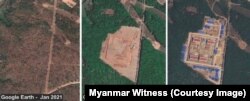Myanmar’s military regime has undertaken a major expansion of the country’s prison system since toppling an elected government three years ago, according to new analysis of satellite data, amid a bloody civil war and crackdown on pro-democracy activists.
Rights groups fear the expansion portends more arbitrary arrests, prisoner abuse and forced labor.
By scouring open-source satellite images from the months leading up to the February 2021 coup through last month, Myanmar Witness, a project of the U.K.-based Center for Information Resilience, found dozens of new buildings inside and next to existing prisons and whole new prisons built or begun around the country. It shared the findings in a report issued January 31, just before the February 1 anniversary of the putsch.
“As activists and civil society continue to be arrested and detained by the Myanmar military, in many cases arbitrarily and without trial, this report reveals the scale of growth in the regime’s repressive prison complex,” Myanmar Witness project director Matt Lawrence told VOA.
He said their research found evidence of new detention facilities or expanded perimeters “in almost half of the prisons we mapped.”
The team said it found 33 new structures at 25 of the 59 prisons it mapped, as well as “large perimeter expansions” at another two in Sagaing region, the scene of some of the stiffest armed resistance to the junta.
Though many of the structures are outside the prisons’ walls, Myanmar Witness said their “high-security design” bears the hallmarks of detention facilities.
“We assessed these additional structures as most likely being used for prisoner accommodation because of the appearance of double fencing along the entire perimeter in satellite and other imagery,” Lawrence said.
“Some larger additions appeared to have small gatehouses on the entrances or a security entrance gate, and some other additions appeared to have a watchtower adjacent to the perimeter,” he added.
The team said it also mapped two new prisons built since the coup, one in Sagaing and another in Mon state, and a third nearing completion in Ayeyarwady state. Since completing its analysis for the report, Lawrence told VOA they also mapped a fourth new prison underway in Bago region.
Myanmar Witness labeled six of the 59 sites it mapped as unconfirmed prisons for various reasons. It says one site may have been abandoned and that others had the telltale signs of a typical prison but did not appear on the regime’s official list.
On the whole, though, Lawrence said the team’s inventory of the growth of Myanmar’s prison system was probably an underestimate, given the limits of open-source data.
That growth comes amid a wave of arrests of those resisting the junta, from armed rebels to online critics, even journalists for covering the news. The junta has outlawed any criticism of the regime or the coup.
The Assistance Association for Political Prisoners, a rights groups based in neighboring Thailand tracking the crackdown, said the junta has arrested over 26,000 political prisoners since the coup and that some 20,000 remain in custody.
AAPP founder and joint secretary Bo Kyi said the scale of the prison expansion program uncovered by Myanmar Witness suggests the junta intends to continue arresting many more dissidents in a bid to intimidate the resistance.
“The expansion of prisons mean they will arrest more people who [are] against them,” he told VOA.
“The issue of political prisoners is directly related with current political problems. People [are] against the military and people want to replace military rule to civilian rule. Therefore [the] military junta is trying to create [a] climate of fear,” he said.
In his latest report, from October, the United Nations special rapporteur on human rights in Myanmar, Tom Andrews, said the junta has continued arresting dissidents at a “staggering scale.” They included over 130 people arrested last June for wearing flowers to celebrate the 78th birthday of the junta’s most famous prisoner, Aung San Suu Kyi. The ousted government’s de facto leader was arrested on the morning of the coup and remains in custody serving a 27-year prison sentence on a spate of charges widely seen to have been trumped up.
Andrews’ report describes overcrowded and filthy conditions inside some prisons alongside unchecked abuse and torture, from beatings to rape and genital mutilation. At the time of the report, the AAPP said at least 188 political prisoners had died either in prison or during interrogation from a lack of health care, torture or outright murder.
In July 2022 the regime openly executed four convicted dissidents at Insein Prison, the country’s first use of capital punishment in decades. More than 100 others remain on death row.
If the new prisons, expanded perimeters and prison buildings uncovered by Myanmar Witness portend more prisoners, they also portend more prisoner abuse, said Manny Maung, Myanmar researcher for Human Rights Watch.
“If you’ve ... got these new structures where they plan on putting people in after summary trials that are completely opaque already and then taking them somewhere else where we have no insight or no visibility on, I think the risk of abuse in detention is extremely high,” she told VOA.
She also said she worries that the junta may be adding prison capacity to boost its supply of forced labor.
“Because they have a history of labor camps, they have a history of forced recruitment and portering. Certainly this forced labor is something ... I would be increasingly worried about if they’re filling up these prisons as well,” she said.
Along with the prisons, Myanmar Witness said it used satellite images to map and analyze at least 29 labor camp sites, mostly quarries and farms, and possibly 24 more. While they did not show the same degree of development and expansion as the prisons, it says most appeared to still be active.










